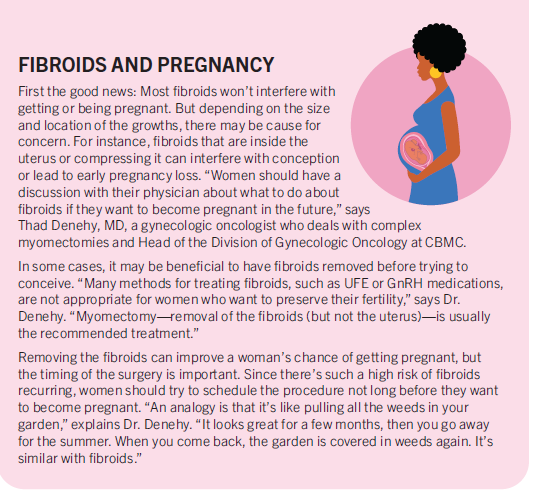
If you’re a woman reading this article, there’s a good chance you have—or had or will have—uterine fibroids. “By the age of 50, as many as 70 to 80 percent of women may have fibroids,” says Eric Liberman, DO, Director of Minimally Invasive Gynecologic Surgery at Cooperman Barnabas Medical Center (CBMC). Fortunately, most women with fibroids won’t experience any symptoms or need treatment. Many women will never even know they have them. But for the approximately one-third of women with fibroids who will experience symptoms, there are many treatment options.
 WHAT ARE FIBROIDS?
WHAT ARE FIBROIDS?
Fibroids are noncancerous growths in the uterus. There are several types, defined by their location. Intramural fibroids are contained within the uterine wall. Submucosal fibroids protrude into the uterine cavity. Pedunculated fibroids are attached to the outside of the uterine wall by a stalk. What mainly determines whether fibroids will cause symptoms are their size and location. “Location is what matters most,” explains Dr. Liberman. “Submucosal fibroids are usually the ones that cause the most problems.”
Symptoms can include heavy menstrual bleeding (which can be severe enough to cause anemia); pelvic pain, pressure or bloating; increased urinary frequency and constipation. In very rare cases, fibroids can be dangerous if they grow so large that the uterus expands and compresses blood vessels and other structures in the pelvis.
Fibroids may stay the same size, grow larger or even shrink over time. “Once a woman reaches menopause, fibroids tend to shrink,” says Dr. Liberman. “We don’t know if it’s estrogen, progesterone or a combination of the two hormones that cause fibroids to grow.”
Many women will only find out they have fibroids during a routine pelvic examination or on unrelated imaging.
OPTIONS FOR TREATMENT
In the past, symptomatic fibroids were almost always treated by surgical removal. And while that’s still a treatment recommended for many women, there are other options:
1. OBSERVATION: A doctor may decide to monitor the growths by doing repeat imaging every few months to assure they’re not increasing in size or number. If symptoms are mild, a woman may not need any treatment or may be able to manage discomfort with over-the-counter pain relievers like ibuprofen.
2. PRESCRIPTION MEDICATIONS: There are new prescription medications available that can reduce the heavy bleeding associated with fibroids. “But these medications can only be used up to 24 months because there’s a risk of bone loss and other side effects with longer use,” says Dr. Liberman.
3. UTERINE FIBROID EMBOLIZATION (UFE): “This is a procedure done by an interventional radiologist,” says Dr. Liberman. “The radiologist places a catheter in the patient’s groin. Using CT scan guidance, they guide the catheter to the blood vessels that supply the fibroids. They put a substance into the feeding blood vessels to decrease the fibroid’s blood supply.” This procedure, he says, is most successful in women 45 and over since those women often only have another five years or so before menopause, so the risk of recurrence is lower.
4. HYSTEROSCOPIC FIBROID RESECTION (ALSO CALLED HYSTEROSCOPIC MYOMECTOMY): “This is a procedure that’s done without any incisions,” explains Dr. Liberman. “A camera is inserted into the uterus through the vagina, and fibroids within the cavity of the uterus, or partially in the cavity, can be removed.”
5. MYOMECTOMY: “This is a surgery to remove just the fibroids,” says Dr. Liberman. “It can be done through an open surgical approach or laparoscopically.” This procedure is mainly recommended for women who want to retain their fertility [see box, below]. Patients need to understand that the risk of new fibroids forming may be as high as 60 percent.
6. HYSTERECTOMY: “This surgery—removal of the uterus—is the only definitive management for symptomatic fibroids. Once you have your uterus removed, you’ll never have another fibroid or associated bleeding,” says Dr. Liberman. The surgery can usually be done minimally invasively with only tiny incisions. “Some patients can go home the same day,” he says. About 600,000 hysterectomies are done in the United States each year, and the most common reason for the surgery is fibroids.
Which treatment, if any, is right for you is something you need to discuss with your doctor. If you’re experiencing the previously mentioned common fibroid symptoms, make sure your doctor knows your concerns. “Often, patients think the amount of menstrual bleeding they’re experiencing is normal, but it is not,” says Dr. Liberman, explaining that in those cases patients may have anemia and the cause can go unrecognized. “It’s important that women are aware of fibroids so they can be their own advocates,” he says.

For more information about Dr. Denehy or Dr. Liberman, please call 973-243-9300.